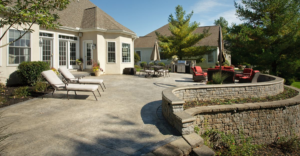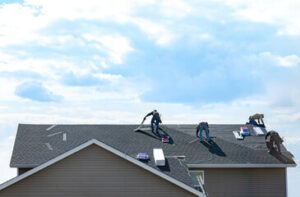Concrete Patio Dallas allows homeowners to transition their indoor living spaces to outdoor spaces seamlessly. It offers unlimited design options, including sleek modern looks or mimicking natural stone paving materials.
However, concrete patios must be properly laid and sealed to withstand weather-induced damage. Cracks aren’t just an aesthetic concern but can also lead to water infiltration and shifting ground.

Concrete is a durable material, and as long as it is properly installed, a concrete patio will last for years with minimal damage. The durability of a concrete patio is further enhanced when reinforcement rods and backer rods are added during the construction process. Reinforcement makes the concrete stronger and more resistant to cracking. It is also important that the correct psi (pound per square inch) is used for your concrete project. 3500 psi is recommended for warmer climates, while 4000 psi is a good choice for colder areas.
Unlike pavers, which may shift and become uneven over time, a poured concrete patio will not be affected by movement in the soil underneath it. Large concrete slabs, however, can be prone to cracking if too much pressure is placed on them. To minimize this potential problem, contractors install control joints in concrete during the curing stage. Control joints are pre-cut lines in the concrete that promote cracking in desirable locations and prevent unwanted cracks.
Another way to increase the durability of a concrete patio is by adding aggregate, which will make it more resistant to damage and improve its strength and stain resistance. Aggregate can be sifted, added, or ground into the surface of a concrete patio to create a more visually appealing and functional texture.
Like any other surface, a concrete patio requires regular maintenance and care to preserve its beauty and functionality. It should be sealed every two to three years to protect it from moisture infiltration and staining. In addition, the concrete should be swept regularly to remove debris and keep it looking clean and new.
Although a concrete patio is a great option for any Bozeman or Big Sky area home, it is important to understand its drawbacks as well as its benefits. A concrete patio is not a good choice for homeowners on a tight budget, as it can be costly to repair any cracks that occur. This is particularly true in our Montana climate, where thawing and refreezing causes concrete to shift and crack over time. This can be a problem for homeowners who want their patio to last for as long as possible.
Aesthetics
Concrete patios can be designed to complement a wide range of design aesthetics. For example, they can be stamped and colored to mimic the appearance of more expensive materials such as stone or brick. This versatility allows homeowners to create a custom outdoor space that perfectly suits their preferences and tastes. Concrete patios also offer a high level of durability that withstands weather changes and heavy use.
To add some visual interest to a plain concrete patio, you can hang cafe lights from the ceiling. This will not only brighten the area, but it will also create a relaxing ambiance for al fresco dining. Be sure to calculate how many strands of lights you will need and spread them evenly across the ceiling.
Another way to dress up a basic concrete patio is by incorporating natural wood accents. This can help warm up a cool gray patio and match the wood features of your home. You can add a simple wood coffee table and some comfortable seating to make the space perfect for entertaining. You can also incorporate woven textures to add a modern rustic touch to the space.
If you want to create a more traditional look for your patio, you can choose tan colored concrete. This will give the concrete a light, fresh color that will complement any type of house elevation. You can also opt for a more earthy brown hue like deep umber or walnut. These colors will work best with more classic homes and will complement terra cotta elements and Spanish-style houses.
A concrete patio can also be stained to achieve a more unique and stylish look. You can even choose a stain that has reflective properties to help reflect sunlight and keep the patio cooler. Staining your concrete patio can be a quick and inexpensive way to upgrade the space, and it will require minimal maintenance in comparison to other options.
While concrete is a durable material, it can be slippery when wet. This can cause accidents, so it is important to take precautions when using the patio. In addition, concrete can crack over time, so you will need to have it resealed periodically.
Maintenance
A concrete patio extends your living space outdoors and is a great spot for entertaining friends and family. But, like any other part of your home, it will require some maintenance to keep it looking good and in tip-top shape. Luckily, unlike other types of outdoor flooring, a concrete patio doesn’t need to be resealed for years after installation.
While concrete is durable, it does require regular cleaning to remove dirt and debris that can stain the surface. A simple broom and hose can keep your concrete patio looking clean, but to really brighten it up, you can use a nylon scrub brush or power washer. Concrete can withstand the pressure, but be careful not to overuse a power washer, which may damage the surface.
It’s also a good idea to use coasters or mats when placing furniture on your concrete patio. This will prevent direct contact between the concrete and potentially staining materials like drink glasses, planters, or rugs. You can also use a non-slip surface treatment to prevent slipping accidents.
Concrete is typically resistant to cracking, but it can be damaged by heavy loads and freezing/thawing cycles. It’s important to inspect your concrete frequently and repair any cracks right away. This will help keep water from seeping through the surface and causing further problems, such as ground settlement or foundation issues.
If you notice any stains, such as oil spills or rust marks on metal furniture, clean them immediately. This will prevent them from spreading and staining the entire patio. If the stains are more stubborn, muriatic acid can be used to break down the minerals that cause them. Be sure to wear proper safety equipment when using this chemical and follow the manufacturer’s instructions.
A concrete patio can be a great addition to your luxury home, but it’s essential to understand its pros and cons before you start planning your project. With the right care, a concrete patio can last for decades and provide a beautiful focal point for your backyard. For more information about constructing your dream concrete patio, contact Premier Homes today! We are dedicated to crafting upscale living experiences for our clients throughout the DC Metro area and Northern Virginia.
Cost
If you are looking for a durable and affordable way to extend your home’s living space, a concrete patio might be the perfect solution. However, before you decide to install a concrete patio, it is important to understand the costs associated with this project. The type of finish, grade of concrete, and location can all impact the final cost.
The cost of a concrete patio varies depending on the size and complexity of the project. A basic concrete slab is the lowest-cost option, but you can also add a variety of textures and finishes to create a unique design. You can choose from brushed, textured, stenciled, or engraved concrete to give your patio a custom look. These options increase the cost but can make your patio more attractive and functional.
In addition to the price of the materials, you will need to budget for labor and other expenses. Poured concrete patios are typically installed by professional contractors, and the cost of their labor can vary. The labor cost will also depend on the site’s accessibility, soil conditions, and slope. If the site is difficult to access or requires extra work to prepare it (such as adding soil amendments), this will increase the labor costs.
Choosing a concrete contractor with experience in installing patios is an excellent way to ensure that your project is completed properly. This will help to reduce the cost of your patio and improve its longevity.
Once your concrete patio is complete, it will require routine maintenance to keep it in good condition. This includes sweeping, hosing down, and sealing. Regular cleaning will prevent dirt and debris build-up, which can damage the surface. Sealing your concrete will protect it from stains, water damage, and UV rays.
The main disadvantage of a concrete patio is its tendency to crack over time, especially in climates with extreme temperature changes. This can be costly and difficult to repair. However, if you have a well-supported base underneath your patio, this should be less of an issue. Additionally, a concrete patio is hard on the feet and can be uncomfortable to walk on for extended periods of time. Adding outdoor rugs or cushions can help mitigate this discomfort.

